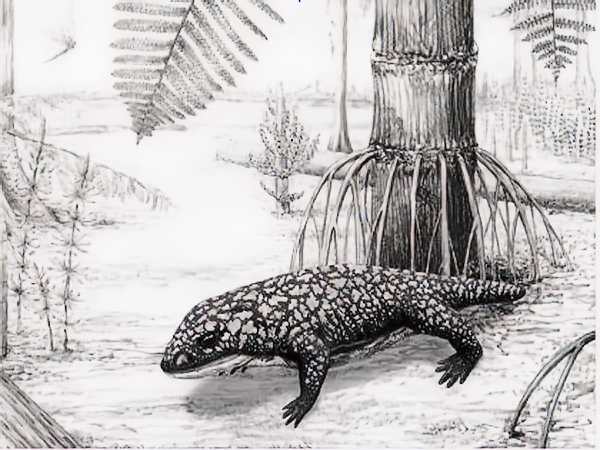A fascinating discovery has surfaced from the badlands of Pennsylvania, where paleontologists have identified a meat-eating amphibian that roamed the area some 300 million years ago. This week, the team led by David Berman from the Carnegie Museum of Natural History in Pittsburgh introduced Fedexia striegeli to the world, a creature whose fossilized skull provides new insights into early terrestrial vertebrates.
Discovery and Naming of Fedexia Striegeli
The current issue of the Annals of Carnegie Museum journal details the discovery and significance of Fedexia striegeli. The name honors Federal Express, which owns the land where the fossil was found, and Adam Striegel, the amateur fossil hunter who discovered the skull. Striegel, then a senior at the University of Pittsburgh, stumbled upon the fossil in 2004 on a road-cut owned by FedEx.
David Berman expressed his admiration for Striegel’s find, stating, “What is particularly amazing about this discovery is that it was made by an amateur who had no prior experience in recognizing vertebrate fossils in the rock, a talent that usually takes years to develop.”
Characteristics of Fedexia Striegeli
The fossilized skull of Fedexia measures approximately five inches in length, suggesting it was a formidable predator of its time. The study notes that this creature represents some of the earliest vertebrates adapted to life primarily on land. Unlike many amphibians of its era, Fedexia likely spent most of its life on land, returning to the water only to lay eggs.
Geological Context and Climate
Dating of the fossil was achieved through chemical comparison with the surrounding rock layers in western Pennsylvania. During the time Fedexia lived, the region was near the equator and experienced a dry climate following a wetter period that had previously fostered the emergence of early land animals. The study highlights that while Fedexia was adapted to terrestrial life, aquatic amphibians still dominated the Pennsylvanian vertebrate assemblages.
The drying of swampy terrains during this period may have driven the evolution of land-dwelling creatures. The emergence of creatures like Fedexia indicates a significant shift in the vertebrate assemblage, with more animals adapting to terrestrial environments as water sources became scarcer.
Evolutionary Significance
Fedexia striegeli lived around 70 million years before the first dinosaurs appeared, marking a critical point in the evolutionary timeline. The study suggests that the adaptation to a terrestrial existence was a significant evolutionary step, allowing vertebrates to explore and dominate new ecological niches on land. This discovery adds valuable information to our understanding of how vertebrates transitioned from aquatic to terrestrial environments.
Implications for Paleontology
The discovery of Fedexia striegeli underscores the importance of amateur contributions to paleontology. Adam Striegel’s find has provided researchers with crucial data, enabling them to piece together the evolutionary history of early terrestrial vertebrates. The collaboration between amateur fossil hunters and professional paleontologists can lead to significant scientific advancements, as demonstrated by this remarkable discovery.
Conclusion
The identification of Fedexia striegeli as a meat-eating amphibian that lived 300 million years ago in Pennsylvania offers a fascinating glimpse into the distant past. This discovery sheds light on the early adaptation of vertebrates to terrestrial life, a pivotal moment in evolutionary history. As researchers continue to study the fossil and its implications, we can expect to learn even more about the complex journey of life from water to land.
The story of Fedexia striegeli is a testament to the enduring value of paleontological research and the unanticipated contributions that can come from dedicated amateurs. It also highlights the dynamic and ever-evolving nature of our understanding of prehistoric life on Earth.
This is Updated post Fossil amphibian in Pennsylvania

